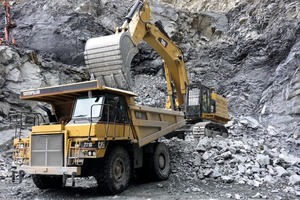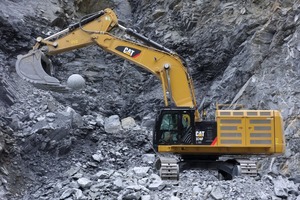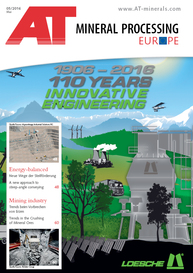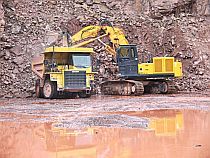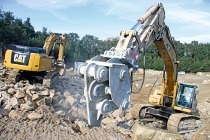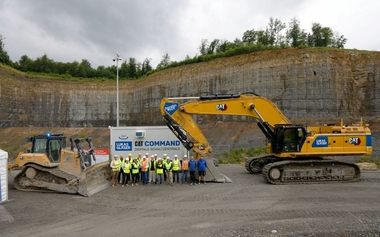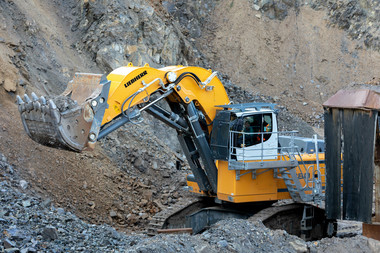Change in extraction method
Whether a shovel excavator or backhoe excavator is used to extract material depends essentially on the prevailing geology and extraction technology. At the diabase quarry of Reichenbrecher & Rentsch, a hydraulic excavator was to be used to extract raw material from the water on the bottom level – that was the future plan. The quarry operators want to go down deeper for extraction, by an additional 14 m, to reach the deepest point at 50 m. The material was loaded up to now by a Cat 365 shovel excavator – but the change in the extraction method makes a backhoe excavator the better choice. For this reason, the company invested in a Cat 374F.
An ME version of this machine was delivered by Herbert Behringer, Sales Representative of Zeppelin’s Erlangen branch. The abbreviation ME indicates a 7-m-long boom with an around 3-m-long stick, which in this combination is to improve performance with hard materials like rock of the diabase category and is designed for bulk handling. On account of the special boom geometry, the machine achieves a higher excavation capacity and a greater digging force than a standard model. The front linkage and cylinder are designed for improved durability, which is essential in this tough application. To be on the safe side, an additional cylinder guard is fitted. The machine needs it too as it has to work with a drop ball, which is clamped between two bucket teeth (Fig. 1). The machine operator drops the ball to break the rock loosened by the borehole blasting into smaller pieces that are easier for the crusher to handle. “With regard to the investment costs, the capital commitment for a backhoe excavator is lower than for a hydraulic excavator with a face shovel. In addition come the wider possibilities for reusing the excavator and the higher residual value on the international market for used machinery,” says Stephan Bothen, Zeppelin Branch Manager in Erlangen, presenting an argument in favour of the investment.
What’s also important: during extraction of the raw material under the own standing base, the digging and lifting forces can act as they are supposed to. In addition, the work cycles are said to go faster if the excavator with its 4.6-m³-large backhoe loads diabase onto the 771D quarry truck or the 730 dumper truck. Another advantage results from the excavator position. It can take a swing angle between 30 to 50 degrees – it is hardly possible to get a smaller angle (Fig. 2). With the shovel excavator, the driver pushes the material away from the machine – unlike with the backhoe excavator. This works towards the machine. Another difference is that the shovel excavator stands direct on the working level, the backhoe excavator on the other hand is positioned on a heap that it has to keep in shape. “That is, of course, also a disadvantage, which, however, we have accepted. For the excavator operator, it is easier to operate the backhoe excavator. With a machine with shovel, he would have to load forwards, which doesn’t come easy to everyone,” explains Managing Director Gerhard Rentsch.
With the change in the extraction method, the quarry is following a trend that is now prevalent in more and more operations, that is using a large excavator with a backhoe instead of a front shovel. For loosening material, especially material of soil class seven, like diabase, the backhoe variant is now the preferred machine. “We extract green diabase, a volcanic rock with properties that get better, the deeper it lies,” explains Gerhard Rentsch. Because the raw material is of certified quality, the company that has operated its quarry since 1906 directly on the Bavarian/Thuringian border in the heart of Germany has been able to compensate for the at first glance apparent disadvantage of the lack of a motorway connection in Kronach district. This becomes clear when you consider buyers like Deutsche Bahn, which buys track ballast for its test tracks, but also for asphalt mixing plants. A fleet of 18 of the company’s own trucks takes the materials to the customers in Eisenach, Erfurt, Leipzig and Weimar. This fleet is needed specifically for materials within a radius of 200 km if the customers do not have their own articulated lorries. This job done by a Cat 966H wheel loader. The smaller companion in the form of a compact Cat 906 is equipped with a sweeper to ensure clean access roads to the quarry and has a mobile tank to replenish fuel for the big machines, such as the new Cat 374F.
$(LEhttp://

